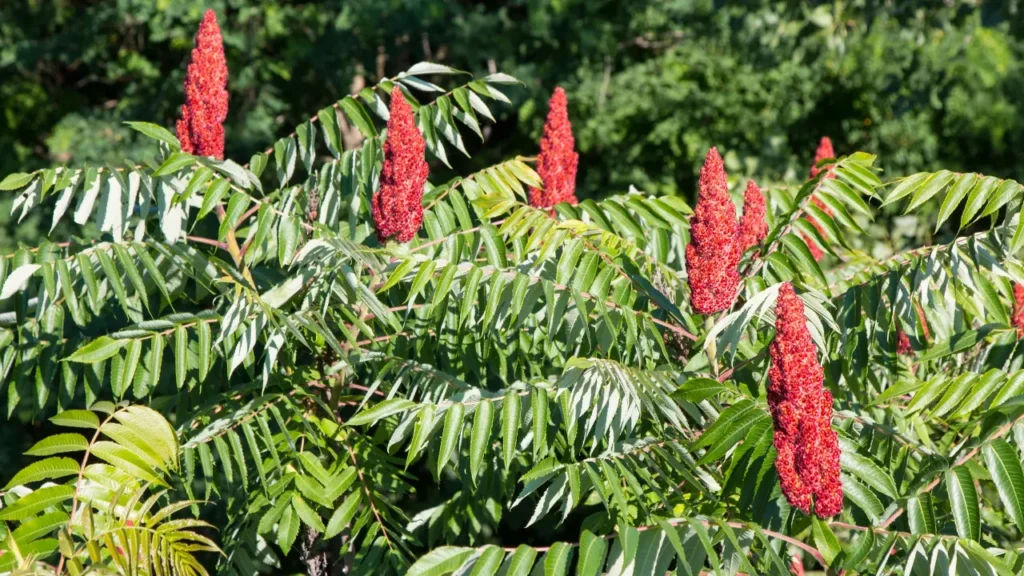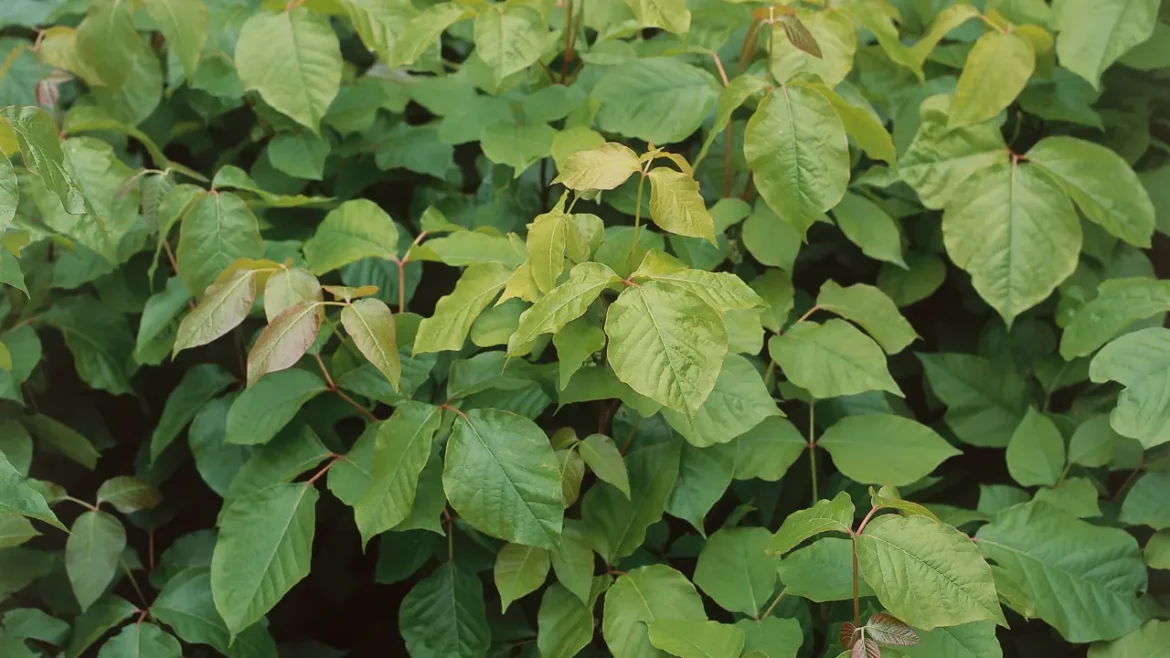Description
The Toxicodendron genus includes plants like poison oak, ivy, and sumac, which are renowned as having toxic oils that may result in allergic contact dermatitis among individuals who are susceptible. It can cause bothersome symptoms like blisters, itching, and redness. This ailment impacts thousands of people every year. In order to control and reduce the resulting allergic reactions, one must have a thorough understanding of the traits, causes, and available therapies for poison oak, ivy, and sumac.
Poison Ivy: A vine or plant known as poison ivy or Toxicodendron radicans has compound leaves comprising three leaflets. The hue and gloss of the leaves fluctuate with the season and might look shiny. It frequently inhabits open fields, riverbanks, and woodland regions.
Poison Oak: Western North America is home to the leafy plant known as poison oak or Toxicodendron diversilobum. Its leaves have lobed edges and the distinctive glossy appearance of oak leaves. The plant may grow into a climbing vine or a ground cover.
Poison Sumac: Small trees and shrubs, known as poison sumac or Toxicodendron vernix, flourish in moist areas like peat bogs and swamps. It possesses complex leaves with seven to thirteen leaflets grouped in pairs. Their leaves are shiny, oval-shaped, and have smooth margins.
You May Also Like:
BPD INSOMNIA: 7 STRATEGIES FOR A RESTFUL NIGHT’S SLEEP
CAN’T SLEEP? WHY NATURAL SUPPLEMENTS MAY BE THE ANSWER
Poison Ivy, Oak, and Sumac: Description, Causes, And Treatment Protocol is an original (HealthXWire) article.
Possible Causes
Contact with the poisonous oil called urushiol is the main contributor to allergic responses to poison oak, ivy, and sumac. The potential causes of getting into interaction with urushiol and these plants are listed below: –
Direct contact with the plants: Getting in touch with the roots stems, or leaves of these plants represents the most frequent trigger of poison oak, ivy, and sumac reactions. Urushiol exposure may occur via brushing against, handling, or unintentionally treading on them.
Indirect contact: Urushiol oil is readily dispersed through the plants to various surfaces, like clothing, pet fur, gardening instruments, or outdoor gear. These infected products can expose people, which might result in allergic responses.
Inhaled particles: Although extremely unlikely, while the plants are burned, it is feasible to inhale urushiol-containing particles. When this occurs, the noxious oil may reach the respiratory system, triggering allergic reactions that harm the airways and lungs.
Contaminated objects: Sporting goods, gardening gloves, or camping gear may all include urushiol if they were brought into exposure to poison oak, ivy, or sumac plants. Inadequate cleaning or handling of these items can result in allergic responses and indirect exposures.
Secondary exposure: Another way that urushiol might be ingested indirectly is by coming into contact with someone else’s skin or clothing. Handshakes, hugs, and sharing of private objects including clothing or towels may all transfer the hazardous oil.
Cross-reactivity: Some people may respond differently to poison oak, ivy, or sumac if they have become allergic to particular plants, like cashews, mangoes, or pistachios. These people may be more likely to experience an allergic reaction if they come into touch with the plants.
Exacerbating and Mitigating Factors
The following are the aggravating factors for poison oak, ivy, and sumac reactions: –
Repeated exposures: Subsequent exposures to poison oak, ivy, or sumac might result in more serious reactions if a person already possesses a sensitivity to them. Urushiol sensitizes the immune system, so successive exposures to the plant cause a stronger reaction.
Prolonged contact: Long-term contact with poison oak, ivy, or sumac poisonous oils enhances the risk and potency of an allergic response. Urushiol oil may penetrate the skin more deeply the longer it is in touch with the skin.
Increased sensitivity: Some people may be more sensitive to urushiol by nature, which makes them more likely to experience severe responses even after only brief exposure. A larger risk applies to those with skin that is sensitive or previous experiences of allergies.
Thin skin areas: The neck, face, and genitalia are examples of body parts with thinner skin that are more prone to severe reactions. Because of the thinner skin, urushiol oil can penetrate more easily, causing more severe sensations.
Warm weather: The allergic reaction may get worse in hot and humid weather. Warm temperatures can cause sweat to rise, which can prolong exposure to harmful oils and exacerbate symptoms.
The following include the mitigating factors for poison oak, ivy, and sumac reactions: –
Immediate action: After coming into touch, you should take urgent action to lessen the adverse reaction. Further exposure can be avoided by taking off the infected clothing and washing it separately. To prevent indirect exposure, it is also crucial to clean any surfaces, tools, or other anything that might have gotten into touch with the plants.
Avoidance: Avoiding close contact with plants that contain poison oak, ivy, or sumac is the best approach to stop an allergic reaction. Knowing how to recognize these plants will help you avoid exposure, particularly in locations where they are common. When entering locations where these plants thrive, wear protective clothing, like long pants, long sleeves, and gloves.
Cleansing: It is essential to wash the affected region with water and soap immediately after any unintentional contact. One must wash the skin thoroughly to get rid of any remaining amounts of urushiol oil, which will lessen its penetration and lessen how bad the response would be. To stop the oil from spreading to other body parts, one should refrain from contacting them.
Here are a few precautions worth employing:
- Barrier creams: Before any potential exposure, the skin can be protected by layering on barrier lotions or creams, including those containing bentoquatam, to lower the possibility of the absorption process of urushiol oil.
- Education and awareness: People can take the proper precautions and seek prompt medical attention if an exposure happens by being aware of these plants’ identification and avoidance techniques along with the signs of an allergic response.
- Environmental control: The removal of poison oak, ivy, or sumac plants from one’s environment can lower the possibility of accidental exposure and subsequent allergic responses, particularly in places where one spends much time.

Standard Treatment Protocol
The following are the usual steps in treating allergic reactions to poison oak, ivy, and sumac:
- Hydrocortisone cream: Hydrocortisone creams available over-the-counter may ease itching and inflammation.
- Calamine lotion: Calamine lotion must be used on the affected region to relieve itching while drying up blisters.
- Aluminum acetate solution: Oozing blisters may be dried and symptoms reduced by soaking into a solution of aluminum acetate, like the Domeboro solution.
- Oral Antihistamines: Antihistamines sold over-the-counter, such as cetirizine (Zyrtec) and diphenhydramine (Benadryl), may relieve itching temporarily. For advice on doses and suggestions, one must speak with a medical expert.
If symptoms do set in, a stronger solution may be necessary. Prescription medications will often be one of the following:
- Topical corticosteroids: To lessen swelling and irritation, apply prescription-strength lotions or ointments incorporating corticosteroids on the affected region.
- Corticosteroids: A healthcare professional may recommend oral corticosteroids such as prednisone to treat symptoms and minimize inflammation in extreme instances or whenever the rash encompasses a significant portion of the body.


Treatment Options
Along with regular treatment choices,
many complementary therapies and natural cures may help reduce symptoms and maybe improve the efficacy of traditional medicines. They consist of the following:
- Aloe Vera: Inflammation and irritation can be relieved by aloe vera plant gel. To provide relief, topically administer aloe vera gel to the afflicted region.
- Witch Hazel: A natural astringent called witch hazel may help in drying up the blisters alongside easing itching. Utilizing a compress or cotton ball, one must administer witch hazel extract.
- Apple Cider Vinegar: Apple cider vinegar diluted with water helps soothe itching. Utilizing a cotton ball and an equal mixture of water and vinegar, the afflicted region should be treated.
- Jewelweed: A plant called touch-me-not, also referred to as jewelweed, is thought to possess anti-inflammatory qualities. One must crush the jewelweed stems and leaves, then apply the liquid to the wounded region.
- Oatmeal Baths: Colloidal oatmeal may ease inflammation and relieve itching when added to bathwater. To feel better, you should bathe for 15 to 20 minutes at a time, 2-3 times per day depending on how sever the rash secretion is.
- Cold Compresses: Itching and inflammation might be reduced by using ice packs or cold compresses on the region impacted. Before using a container of frozen peas or ice packs on one’s skin, they should be wrapped inside a towel.
Some Nutritional Supplements you can try to help strengthen your body against be vulnerable to posion ivy, oak, and sumac could be:
- Vitamin C: Antioxidant properties of vitamin C may improve the immune system and accelerate recovery. It might be advantageous as a complementary therapy.
- Vitamin E: Vitamin E, which has anti-inflammatory qualities, might be consumed as a supplement or topically administered to the injured region to speed recovery.
- Zinc: Supplemental zinc may strengthen the body’s immune system and accelerate healing.
However, before utilizing any complementary treatments or herbal remedies, one needs to seek medical advice, particularly if one has any pre-existing problems, is on medication, is pregnant, or is breastfeeding. Doctors can make recommendations that are unique to the individual and guarantee that the standard treatment procedure is properly integrated.


Conclusion
Understanding and effectively managing allergic reactions to poison oak, ivy, and sumac is crucial for individuals susceptible to these toxic plants. We hope that, from reading the remedies and solutions offered in this guide, that you’ll have a better, more informed chance of combatting the conditions that come about from these plants in the future.
Know that while reactions to these plants are very common, the severity will range from person to person, and therefore no incident of reaction should be discounted as insignificant. Reactions to poison ivy, sumac, and oak can be life-threatening to some, and therefore should be given proper attention to prevent systemic spreading.
With the right amount of precautions, you will be able to handle yourself and others who come into contact with these plants.


Additional resources for further reference
- Poison Ivy, Poison Oak and Poison Sumac. Retrieved from: https://my.clevelandclinic.org/health/articles/10655-poison-plants-poison-ivy–poison-oak–poison-sumac
- POISON IVY, OAK, AND SUMAC: HOW TO TREAT THE RASH. Retrieved from: https://www.aad.org/public/everyday-care/itchy-skin/poison-ivy/treat-rash
- Recognizing Poison Ivy, Oak and Sumac. Retrieved from: https://www.chop.edu/news/health-tip/recognizing-poison-ivy-oak-and-sumac
Important Note: The information contained in this article is for general informational purposes only, and should not be construed as health or medical advice, nor is it intended to diagnose, prevent, treat, or cure any disease or health condition. Before embarking on any diet, fitness regimen, or program of nutritional supplementation, it is advisable to consult your healthcare professional in order to determine its safety and probable efficacy in terms of your individual state of health.
Regarding Nutritional Supplements Or Other Non-Prescription Health Products: If any nutritional supplements or other non-prescription health products are mentioned in the foregoing article, any claims or statements made about them have not been evaluated by the U.S. Food and Drug Administration, and such nutritional supplements or other health products are not intended to diagnose, treat, cure, or prevent any disease.
Table of Contents


